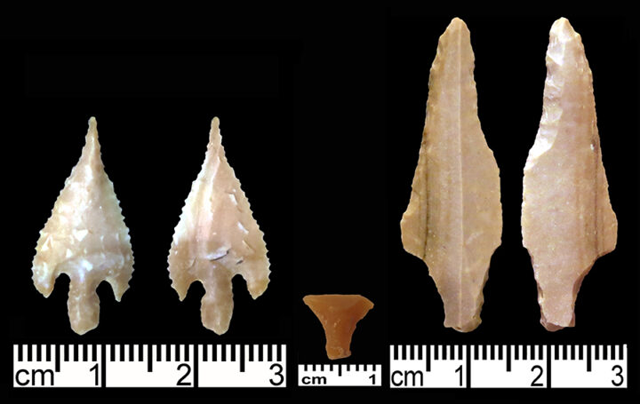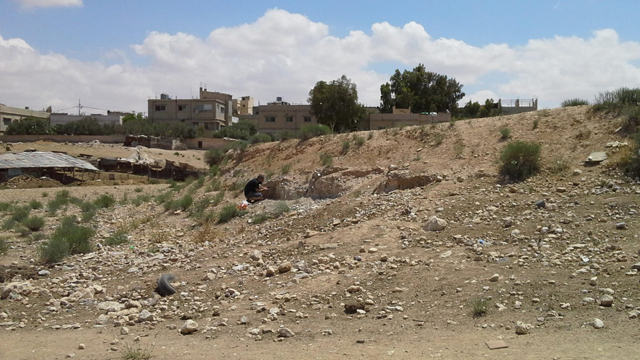You are here
Prehistory of Jordan: Three decades of archaeology insights
By Saeb Rawashdeh - Sep 28,2024 - Last updated at Sep 28,2024

From left to right: Haparsa point; transverse arrowhead; and Badia point (Photo of Gary Rollefson)
AMMAN — The projects dedicated to the Prehistory of Jordan became prominent in the last 30 years, showing an increased academic interest by both local and international experts.
Several archaeological projects combined with palaeo-zoological, palaeo-botanical, geological and palaeo-environmental studies have been conducted to the mountain areas, e. g., Wadi Zarqa/Wadi Duleil, Wadi Hesa, the Hisma, Wadi Hammh and the Petra hinterland.
The gathered information concerned with the hunters and gatherers in central Jordan is based on stone tools found either during surveys or excavations, and on the fossilised animal bones.
In the Lower Palaeolithic, the Dauqra formation, located in the confluence of the Wadi Zarqa with Wadi Duleil area produced flint flakes that were recovered in 1982 – 1983 in the highest and oldest fluvial terrace, noted the scholar Zeidan Kafafi.
"The formation has been restudied in 1996, 1997 and 1999 by the joint Jordanian-Italian team and the excavated artefacts consist only of flakes with few cores and very rare choppers," Kafafi underlined.
Moreover, faunal remains associated with the flint tools were found: Among them there is an elephant tooth excavated in Sukhneh North, which is referred to Mammoths meridionalis Equus, a type of mammoth known before from the ʿUbeidiyyah formation dating to the Early Pleistocene.
This means that the lithic and the faunal remains have been transported and dismembered by the water flow for an unknown distance.
"Also, it may be deduced that the artefacts and fauna might not be contemporaneous. The Middle Acheulean in Jordan is represented by the site Sukhneh North, unless it is of Early Pleistocene context.
In contrast with the Early and Middle Acheulean, the number of sites dating to the Late Acheulean in Jordan is attested to be greater. Does this indicate an increase in the population as it was suggested? Or does it coincide with climatic amelioration?" Kafafi asked.
Sites belonging to the Late Acheulean were identified in the Upper Zarqa/Khirbet Zarqa Group as the Bireh Formation at the Wadi Zarqa/Duleil confluence, the professor continued, adding that it seems that hominids lived in Jordan during the Lower Palaeolithic era, but due to the absence of the human skeletal remains a question remains open, when did hominids live in Jordan?
"Studies devoted to the understanding of the Middle Palaeolithic in Jordan began less than thirty years ago; until then only isolated surface scatters of Levalloisian cores, point, and flakes had been reported from sites across the country," Kafafi said, noting that recent studies related to this period were conducted on four regions of Jordan: Tabaqt Fahl, the Azraq Basin, the Wadi Hasa and the Wadi Hisma.
The common tool type of this industry is side–scrapers, a scholar Levallois points, few burins and notches and denticulates. Similar tool types were encountered at most of the Jordanian Middle Palaeolithic sites, including central Jordan, such as Wadi Zarqa/Duliel in the fringes of the arid land in central Jordan, the Azraq Basin and at many other isolated scattered sites.
"To sum up, it is obvious that the Middle Palaeolithic sites in Jordan are abundant and only a few of them have been investigated to date. Based on the results of his research in Wadi Hisma, Henry stated that the Middle Palaeolithic sites in Southern Jordan were seasonally and elevationally structured within a pattern of transhumance.
He adds that the Jordanian evidence supports the claims that the Middle Palaeolithic settlement patterns in the Levant were diverse and complex, as they are among modern foragers," Kafafi underscored.
Related Articles
AMMAN — Evidence of human occupation in wadis from the Jordanian central massive goes back to the Palaeolithic period as it was evidenced in
AMMAN — At the confluence of the Zarqa and Dulayl rivers, north and west of the town of Sukhna, near Zarqa, many sections have been excavate
AMMAN — According to the professor Zeidan Kafafi, in Jordan, and during the second half of the last century, only very few sites from Pre-Po



















